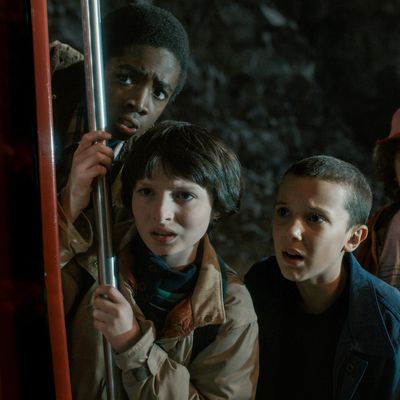
When Will’s body is dredged up from the quarry, the citizens of Hawkins — or at least the citizens we’re following, anyway — can come to one of two possible conclusions:
- Yep, that’s Will’s body all right.
- Nope, this is all part of some nefarious government conspiracy that involves the Department of Energy, a faceless creature, a girl with psychic powers, and a parallel dimension.
Bringing us to the midpoint of Stranger Things in thrilling fashion, “The Body” underlines the theme of community as a binding force against tragedy and evil. Whoever planned the quarry ruse had solid justification to believe that people would accept this cotton-stuffed facsimile for the real thing, despite the peculiar step of having “state agents” perform the autopsy. But the residents of Hawkins know each other, and there’s enough trust between them to make the outlandish seem at least vaguely plausible, and certainly worth a little investigation. If Hopper doesn’t know Joyce, then he writes off what she says as a grief-fueled hallucination. If Mike doesn’t have his friends, then no one will entertain his reports of Will’s voice filtering through his walkie-talkie.
With that, Stranger Things recalls John Carpenter’s 1980 thriller The Fog, which takes place in a coastal California village called Antonio Bay. The hero of that movie, played by Adrienne Barbeau, works as a local radio DJ who broadcasts her show from the top of a lighthouse. The evil forces in The Fog are the vengeful ghosts from a clipper ship that residents of Antonio Bay deliberately sank 100 years earlier, out of fears of a leper colony and greed for the gold on board. Through a plank of driftwood she brings up to the station, Barbeau inadvertently broadcasts a message from the beyond (“six must die”) over the airwaves, presaging an anniversary attack on the town.
Stranger Things borrows the specific conceit of a voice from another dimension piping through the airwaves, but more broadly, it shares The Fog’s desire to make the town itself an important character. The Hawkins Laboratory has been allowed to operate independently, to the point where the local police chief getting a ten-minute tour is reluctantly conceded and deceptively choreographed. Now the key players in the town are finally coming together to find their missing citizens and dispel whatever specters are currently haunting them, much like Barbeau & Co. in The Fog. (Albeit without the baggage of the town’s ancestry creating the mess in the first place.) It makes for a rousing episode, and, better still, puts everyone on the same page for the second half of the season. The characters no longer have to futilely try to convince each other they’re not crazy.
It starts with an itch in Hopper’s brain. After turning up to console Joyce over her son’s death, Hopper instead finds her ranting about Will speaking through a bundle of Christmas lights and black letters she’d painted on the living-room wall. He can relate to the feeling of losing a child and dutifully rationalizes the psychic trauma and lack of sleep that must account for Joyce’s madness. But when she says, “I need you to believe me,” it gets into his head a little — more so even than it does for Joyce’s son, Jonathan, who resents having to make funeral arrangements because his mother won’t acknowledge that Will is gone. The strangeness at the coroner’s office gives Hopper a loose thread to pull on, and the whole conspiracy starts to unravel from there.
Meanwhile, Elle uses her powers to convince Mike that she wasn’t lying about his friend being alive, summoning a haunting rendition of Will’s favorite Clash song through a walkie-talkie. The need for a bigger signal boost gives them the idea of sneaking into the school and using the new ham radio, though it seems far-fetched that a conventional radio signal has any bearing on whether a psychic can communicate with the beyond or not. Nevertheless, the boys disguise Elle in makeup, a dress, and a blonde wig, which is like the scene where E.T. gets dressed up as a woman to phone home, but with an added touch of adolescent Vertigo, given that Mike is changing Elle into a girl he desires. This also leads them to finally, triumphantly get one over on the school bullies, as Elle forces one of them to stand in a puddle of humiliation. (The show will have trouble in the future, though, if it suggests she doesn’t have control over her powers. If you can hone in on the urinary tract, your game is tight.)
The final pieces come together, quite literally, when Nancy tapes together scraps of Jonathan’s photograph and discovers the creature on the far edge of the frame, moments before it snatched Barb from the diving board. Though Nancy has cause to be angry with Jonathan for peeping on her, the issue goes unmentioned — partly because there’s a more urgent matter to discuss and partly because she extends him a little compassion. He’s not a creep or a freak to her, and she knows enough about being an outcast not to relish teasing him like Steve and his awful friends do. With Hopper, Joyce, Nancy, Jonathan, and Mike’s crew all sniffing around the same rat, it’s time for the nerds of Hawkins to go to war.
Demogorgons:
- Joy Division’s “Atmosphere” is an excellent soundtrack choice for the opening sequence. As Hopper goes back to his car after talking to Joyce, the lyrics (“Don’t walk away in silence … see the danger … always danger”) are like his conscience set to music.
- Funny to have both Joyce and Mike say virtually the same thing when asked about going to Will’s funeral. Mike: “No, not his funeral. Screw his funeral.” Joyce: “The funeral? For who? That thing back there?!”
- Beyond a terrific sequence where Dr. Brenner sends a lackey into the creature’s realm with a cable attached to his Hazmat suit, the mystery of the creature’s origins (and Brenner’s motives in handling it) are still tantalizingly up in the air.
- The name of the state trooper who finds Will’s body, O’Bannon, is surely a tip of the hat to the sci-fi legend Dan O’Bannon, who had a hand in scripting Alien and Carpenter’s Dark Star among other achievements.


